CHEVROLET EXPRESS 1997 1.G Owners Manual
Manufacturer: CHEVROLET, Model Year: 1997, Model line: EXPRESS, Model: CHEVROLET EXPRESS 1997 1.GPages: 386, PDF Size: 20.32 MB
Page 211 of 386
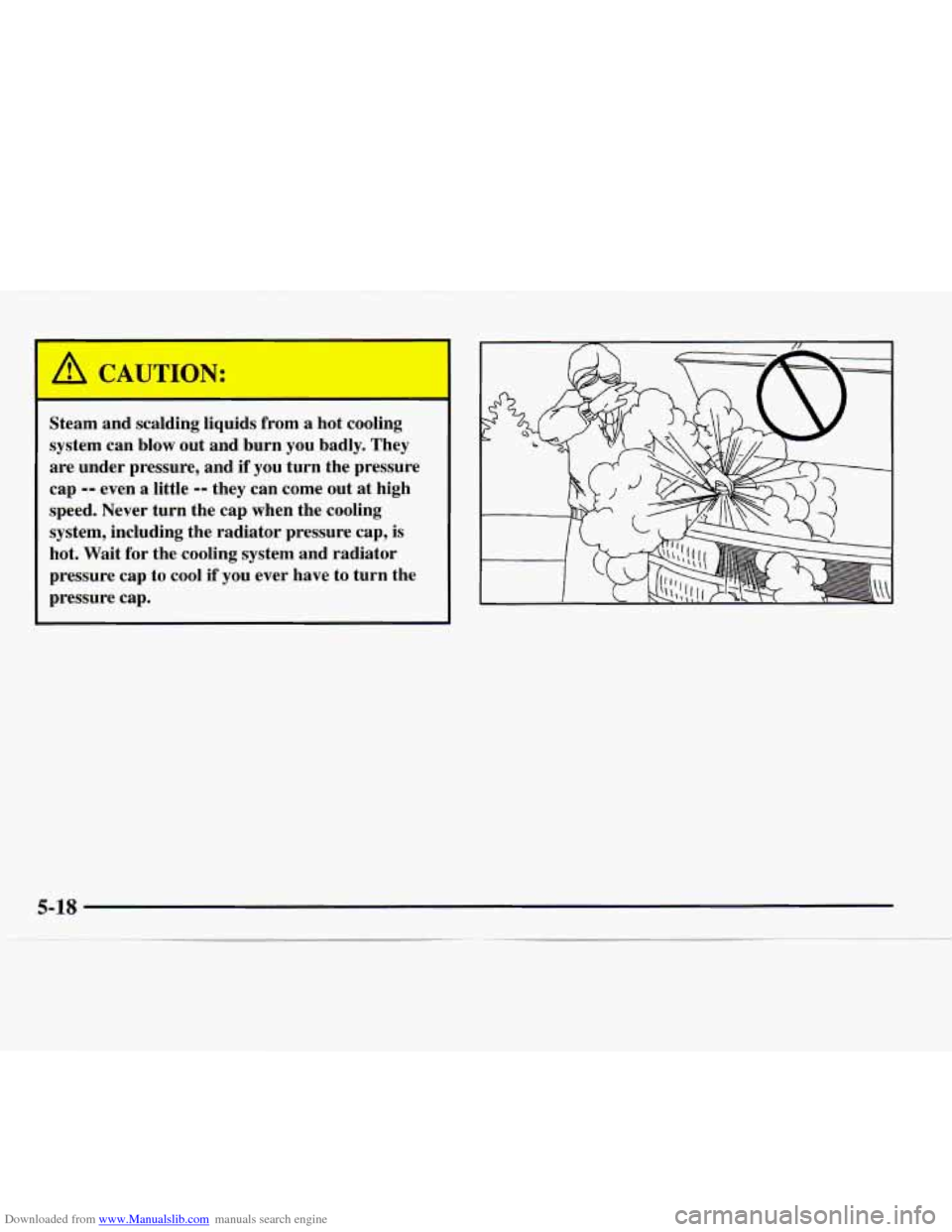
Downloaded from www.Manualslib.com manuals search engine A CAUTION:
- -
Steam and scalding liquids from a hot cooling
system can blow out and burn you badly. They
are under pressure, and if you turn the pressure
cap
-- even a little -- they can come out at high
speed. Never turn the cap when the cooling
system, including the radiator pressure cap, is
hot. Wait for the cooling system and radiator
pressure cap to cool if you ever have to turn the
pressure cap.
Page 212 of 386
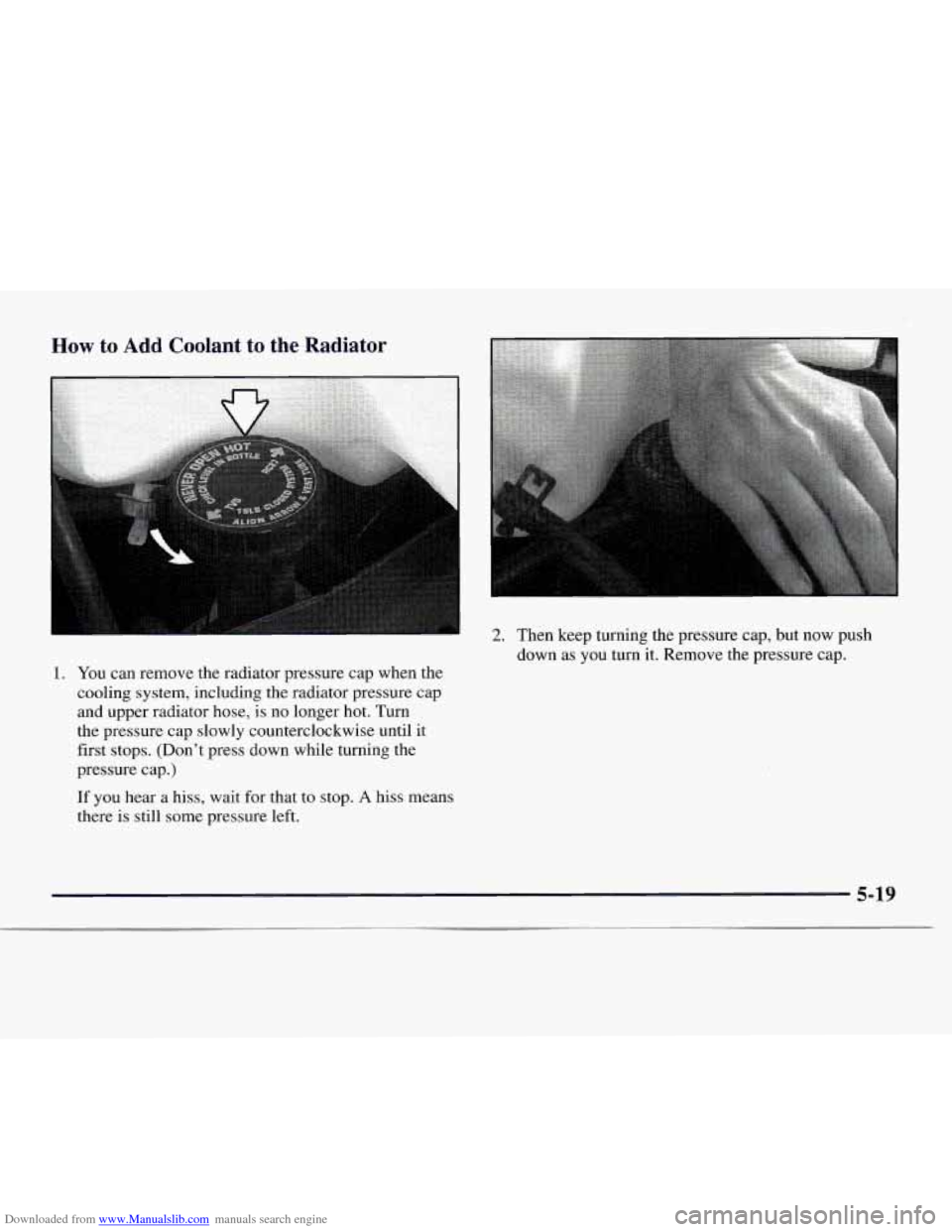
Downloaded from www.Manualslib.com manuals search engine How to Add Coolant to the Radiator
1. You can remove the radiator pressure cap when the
cooling system, including the radiator pressure cap
and upper radiator hose, is no longer hot. Turn
the pressure cap slowly counterclockwise until it
first stops. (Don't press down while turning the
pressure cap.)
' 2. Then keep turning the pressure cap, but now push
down
as you turn it. Remove the pressure cap.
If you hear a hiss, wait for that to stop. A hiss means
there is still some pressure left.
5-19
Page 213 of 386
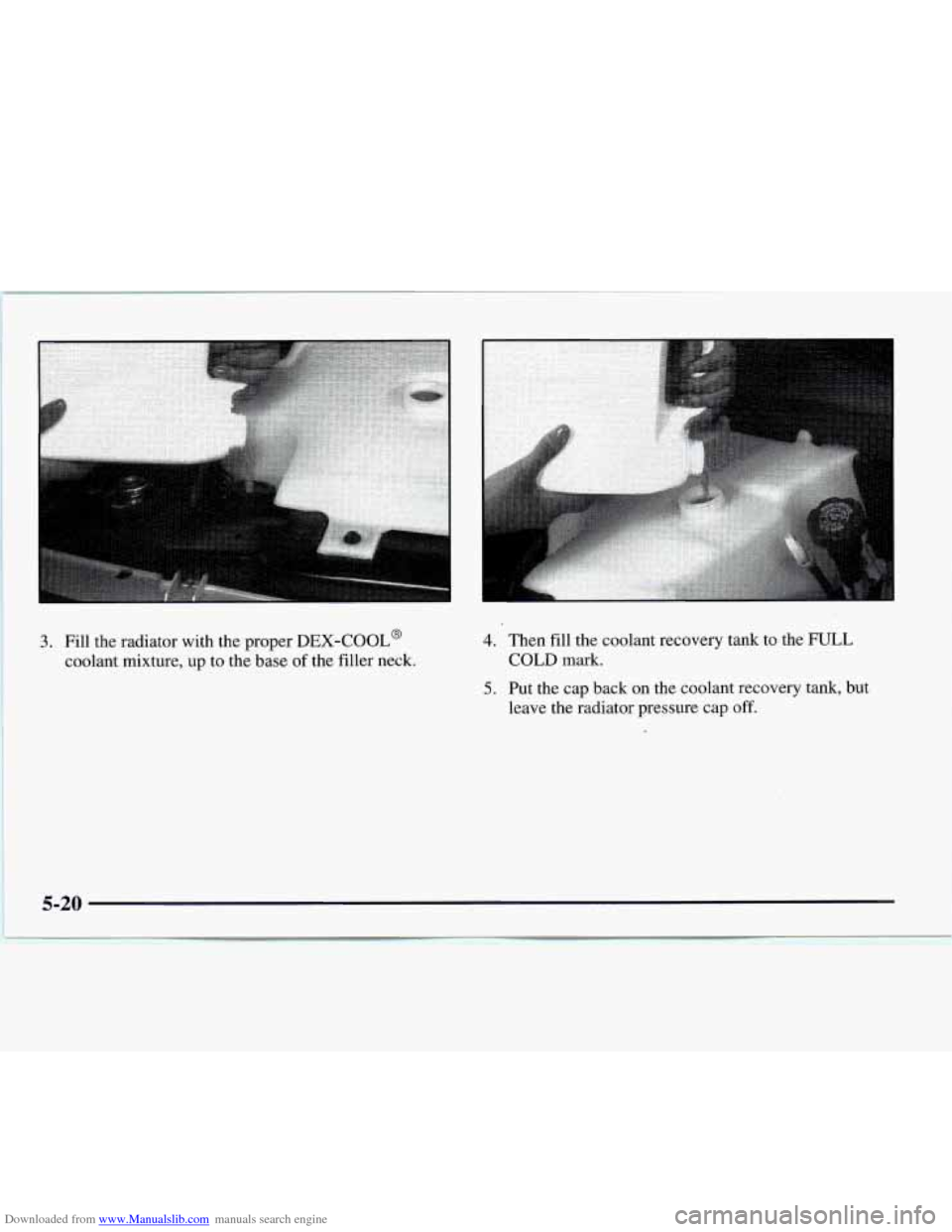
Downloaded from www.Manualslib.com manuals search engine 3. Fill the radiator with the proper DEX-COOL@
coolant mixture, up to the base
of the filler neck.
4. Then fill the coolant recovery tank to the FULL
COLD mark.
5. Put the cap back on the coolant recovery tank, but
leave the radiator pressure cap off.
5-20
Page 214 of 386
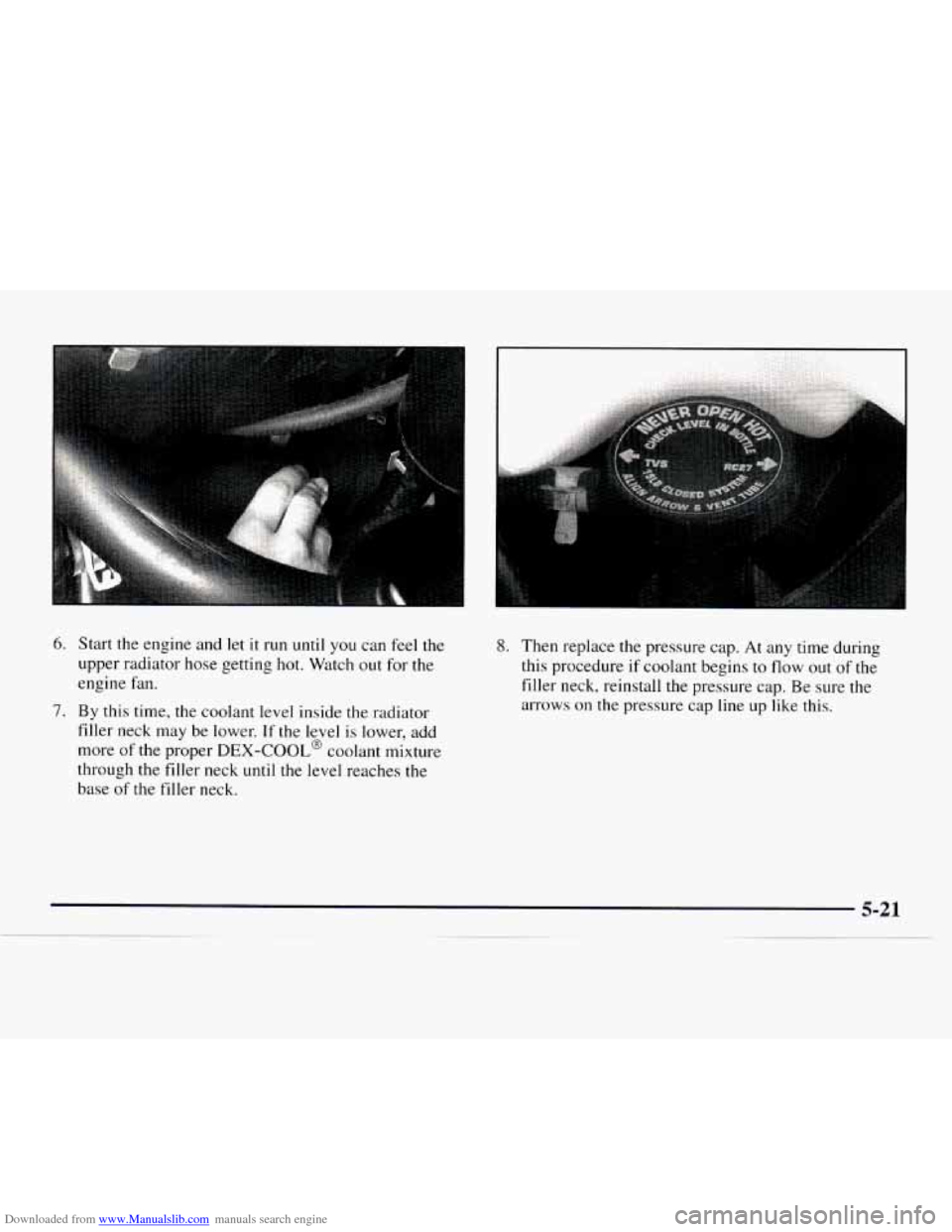
Downloaded from www.Manualslib.com manuals search engine 6.
7.
Start the engine and let it run until you can feel the
upper radiator hose getting hot. Watch out for the
engine fan.
By this time, the coolant level inside the radiator
filler neck may be lower.
If the level is lower, add
more
of the proper DEX-COOL@ coolant mixture
through the filler neck
until the level reaches the
base
of the filler neck.
8. Then replace the pressure cap. At any time during
this procedure
if coolant begins to flow out of the
filler neck, reinstall the pressure cap. Be sure the
arrows
on the pressure cap line up like this.
Page 215 of 386
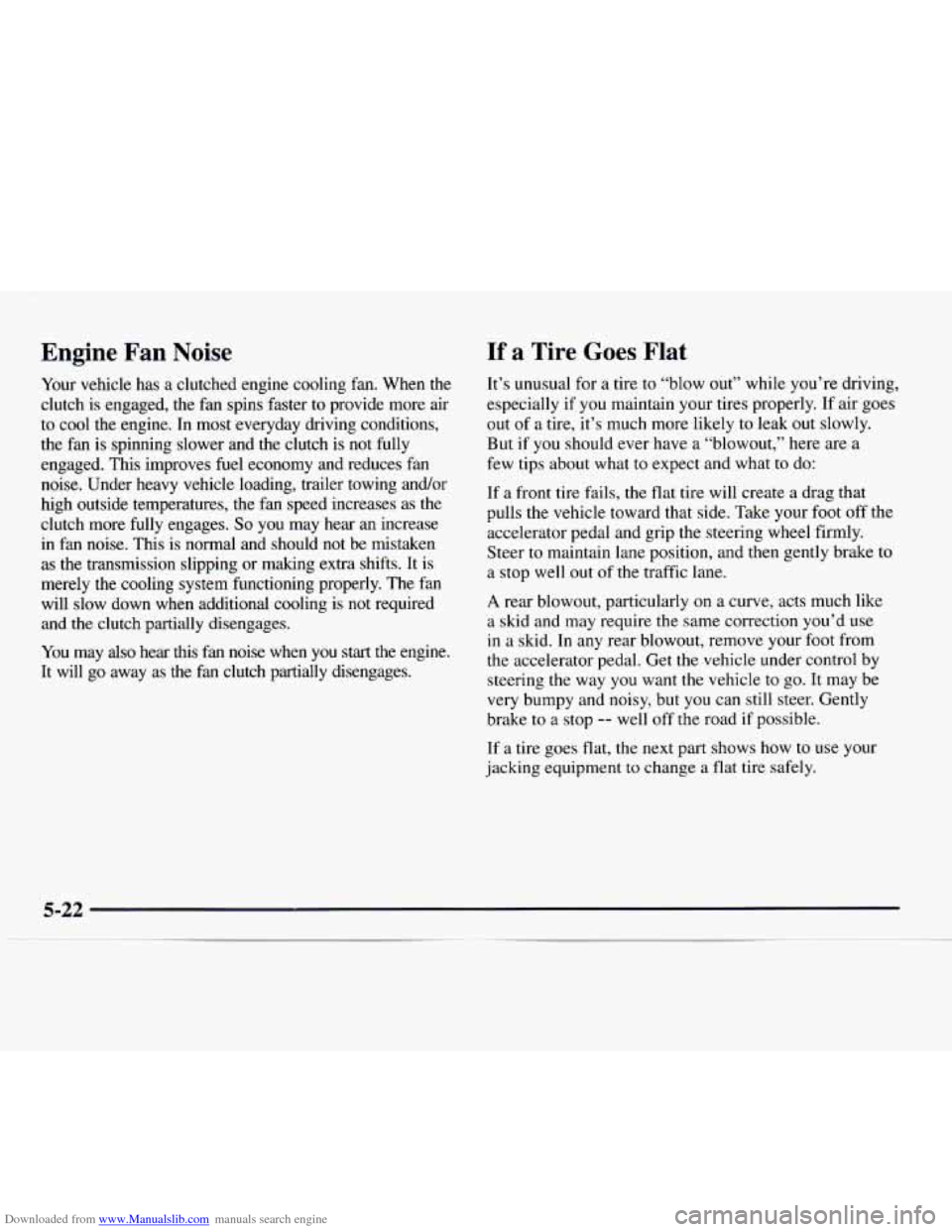
Downloaded from www.Manualslib.com manuals search engine Engine Fan Noise
Your vehicle has a clutched engine cooling fan. When the
clutch is engaged, the fan spins faster to provide more air
to cool the engine. In most everyday driving conditions,
the fan is spinning slower and the clutch is not fully
engaged. This improves fuel economy and reduces fan
noise. Under heavy vehicle loading, trailer towing and/or
high outside temperatures, the fan speed increases as the
clutch more fully engages.
So you may hear an increase
in fan noise. This is normal and should
not be mistaken
as the transmission slipping or making extra shifts. It
is
merely the cooling system functioning properly. The fan
will slow down when additional cooling is not required
and
the clutch partially disengages.
You may also hear this fan noise when you start the engine.
It will go away as the fan clutch partially disengages.
If a Tire Goes Flat
It’s unusual for a tire to “blow out” while you’re driving,
especially
if you maintain your tires properly. If air goes
out of a tire, it’s much more likely to leak
out slowly.
But
if you should ever have a “blowout,” here are a
few tips about what to expect and what to do:
If a front tire fails, the flat tire will create a drag that
pulls the vehicle toward that side. Take your foot
off the
accelerator pedal and grip the steering wheel firmly.
Steer to maintain lane position, and then gently brake to
a stop well
out of the traffic lane.
A rear blowout, particularly on a curve, acts much like
a skid and may require
the same correction you’d use
in
a skid. In any rear blowout, remove your foot from
the accelerator pedal. Get the vehicle under control by
steering the way you want the vehicle
to go. It may be
very bumpy and noisy, but
you can still steer. Gently
brake
to a stop -- well off the road if possible.
If
a tire goes flat, the next part shows how to use your
jacking equipment to change
a flat tire safely.
5-22
Page 216 of 386
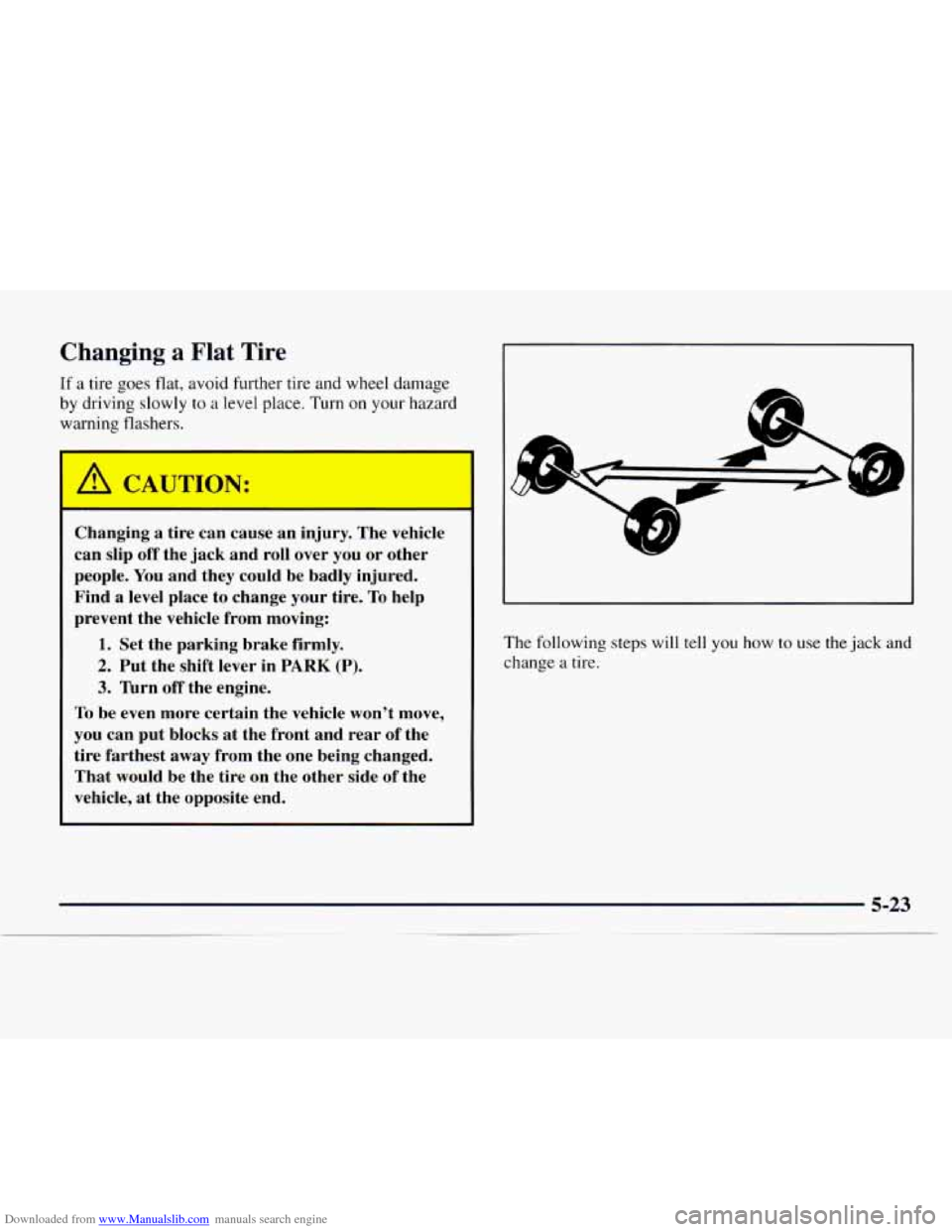
Downloaded from www.Manualslib.com manuals search engine Changing a Flat Tire
If a tire goes flat, avoid further tire and wheel damage
by driving slowly to
a level place. Turn on your hazard
warning flashers.
a CAUl ION:
Changing a tire can cause an injury. The vehicle
can slip off the jack and roll over you or other
people. You and they could be badly injured.
Find
a level place to change your tire. To help
prevent the vehicle from moving:
1. Set the parking brake firmly.
2. Put the shift lever in PARK (P).
3. Turn off the engine.
To be even more certain the vehicle won’t move,
you can put blocks at the front and rear of the
tire farthest away from the one being changed.
That would be the tire
on the other side of the
vehicle,
at the opposite end.
The following steps will tell you how to use the jack and
change
a tire.
Page 217 of 386
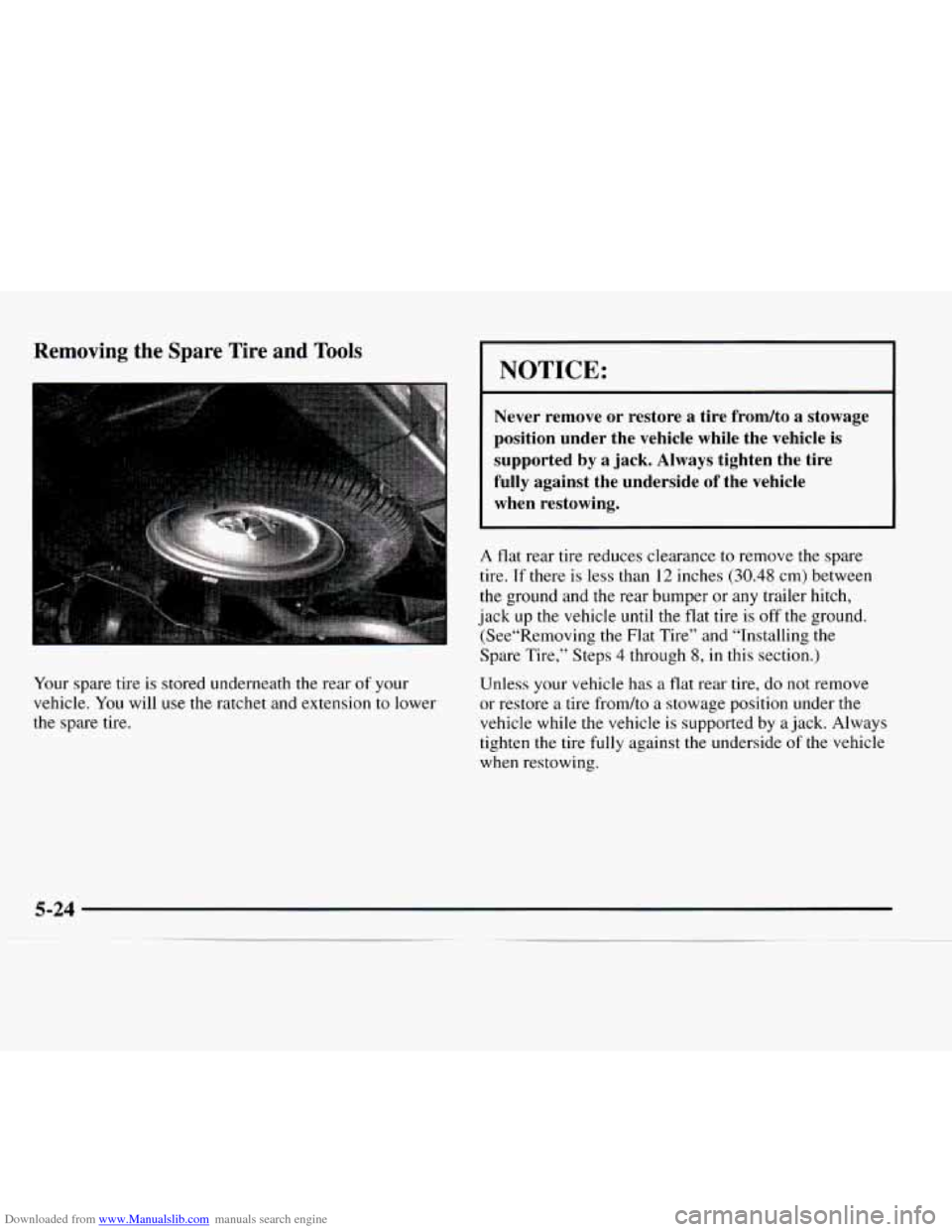
Downloaded from www.Manualslib.com manuals search engine Removing the Spare Tire and Tools
I
Your spare tire is stored underneath the rear of your
vehicle.
You will use the ratchet and extension to lower
the spare tire.
I
NOTICE:
Never remove or restore a tire frondto a stowage
position under the vehicle while the vehicle is
supported by a jack. Always tighten the tire
fully against the underside
of the vehicle
when restowing.
A flat rear tire reduces clearance to remove the spare
tire.
If there is less than 12 inches (30.48 cm) between
the ground and the rear bumper or any trailer hitch,
jack up the vehicle until the flat tire is
off the ground.
(See“Removing the Flat Tire” and “Installing the
Spare Tire,” Steps
4 through 8, in this section.)
Unless your vehicle has a flat rear tire, do not remove
or restore a tire fromho a stowage position under the
vehicle while the vehicle is supported by a jack. Always
tighten the tire
fully against the underside of the vehicle
when restowing.
Page 218 of 386
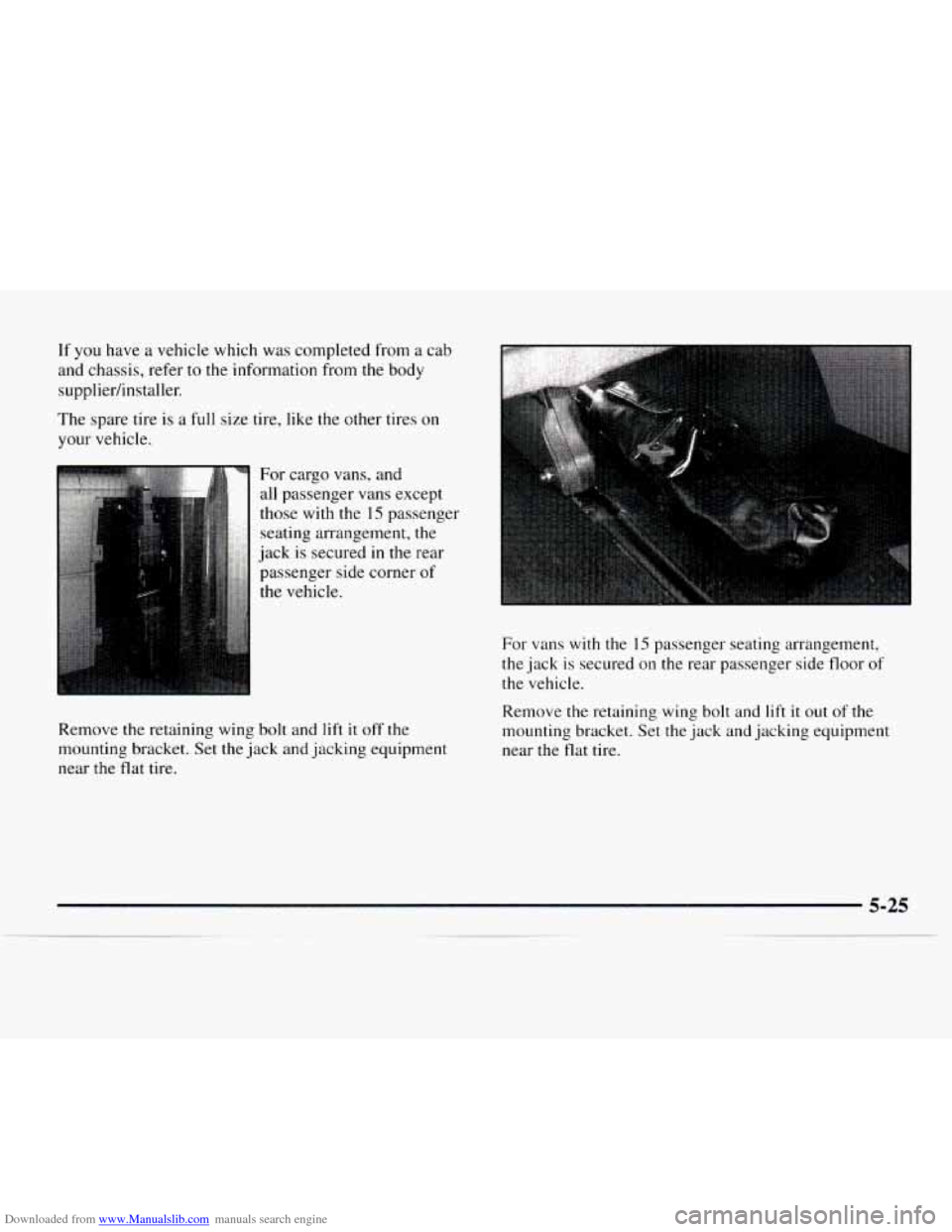
Downloaded from www.Manualslib.com manuals search engine If you have a vehicle which was completed from a cab
and chassis, refer to the information from
the body
supplierhstaller.
The spare
tire is a full size tire, like the other tires on
your vehicle.
For cargo vans, and
all passenger vans except
those with the
15 passenger
seating arrangement, the
jack is secured in the rear
passenger side corner
of
the vehicle.
Remove the retaining wing bolt and
lift it off the
mounting bracket. Set the jack and jacking equipment
near the flat tire. For vans
with the 15 passenger
seating arrangement,
the jack is secured
on the rear passenger side floor of
the vehicle.
Remove
the retaining wing bolt and lift it out of the
mounting bracket. Set the jack and jacking equipment
near the flat tire.
Page 219 of 386
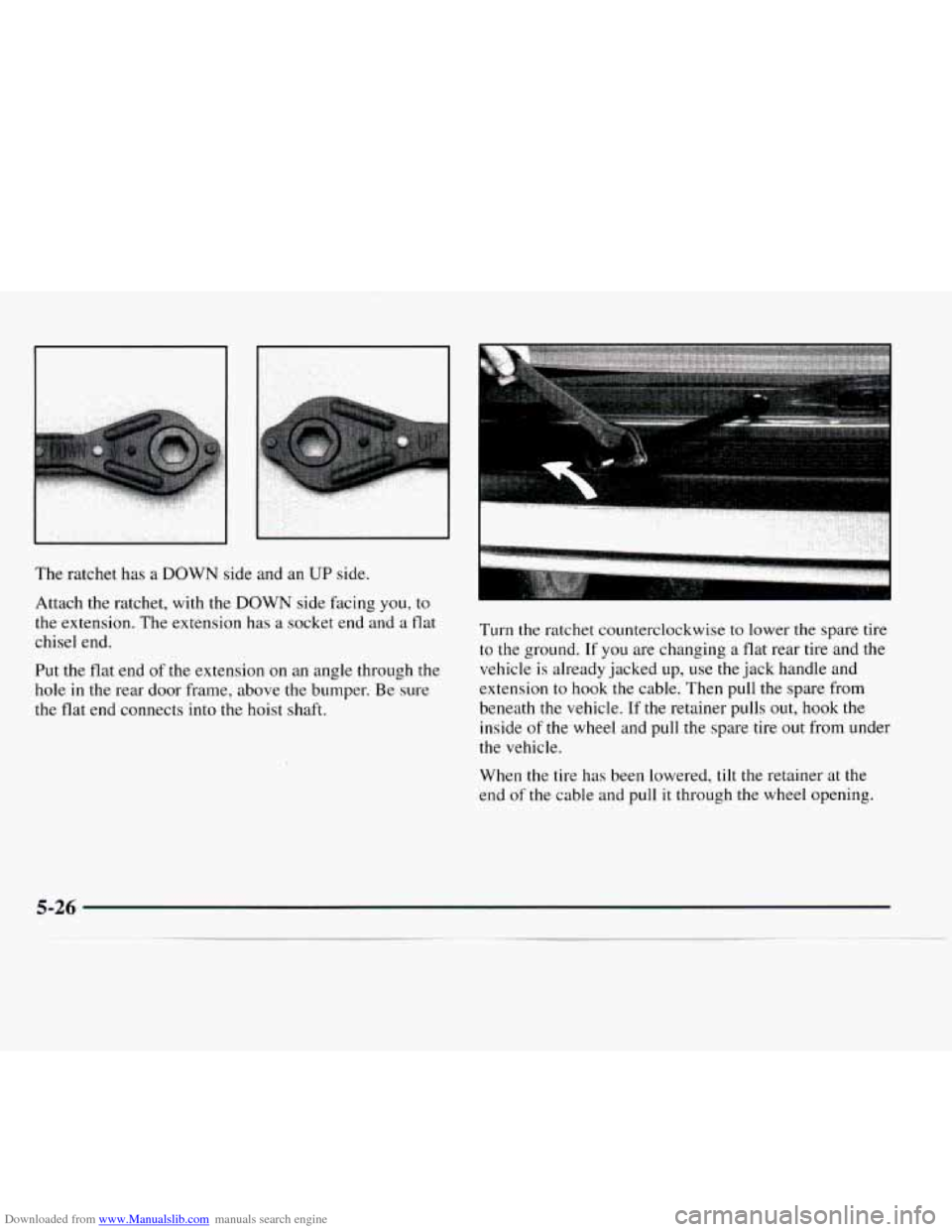
Downloaded from www.Manualslib.com manuals search engine The ratchet has a DOWN side and an UP side.
Attach the ratchet, with the
DOWN side facing you, to
the extension. The extension has a socket end and
a flat
chisel end.
Put the flat end
of the extension on an angle through the
hole in the rear door frame, above the bumper. Be sure
the flat end connects into the hoist shaft. Turn the ratchet counterclockwise
to lower the spare tire
to the ground. If you are changing
a flat rear tire and the
vehicle
is already jacked up, use the jack handle and
extension to hook the cable. Then pull the spare from
beneath the vehicle.
If the retainer pulls out, hook the
inside
of the wheel and pull the spare tire out from under
the vehicle.
When the tire has been lowered, tilt the retainer at the
end
of the cable and pull it through the wheel opening.
Page 220 of 386
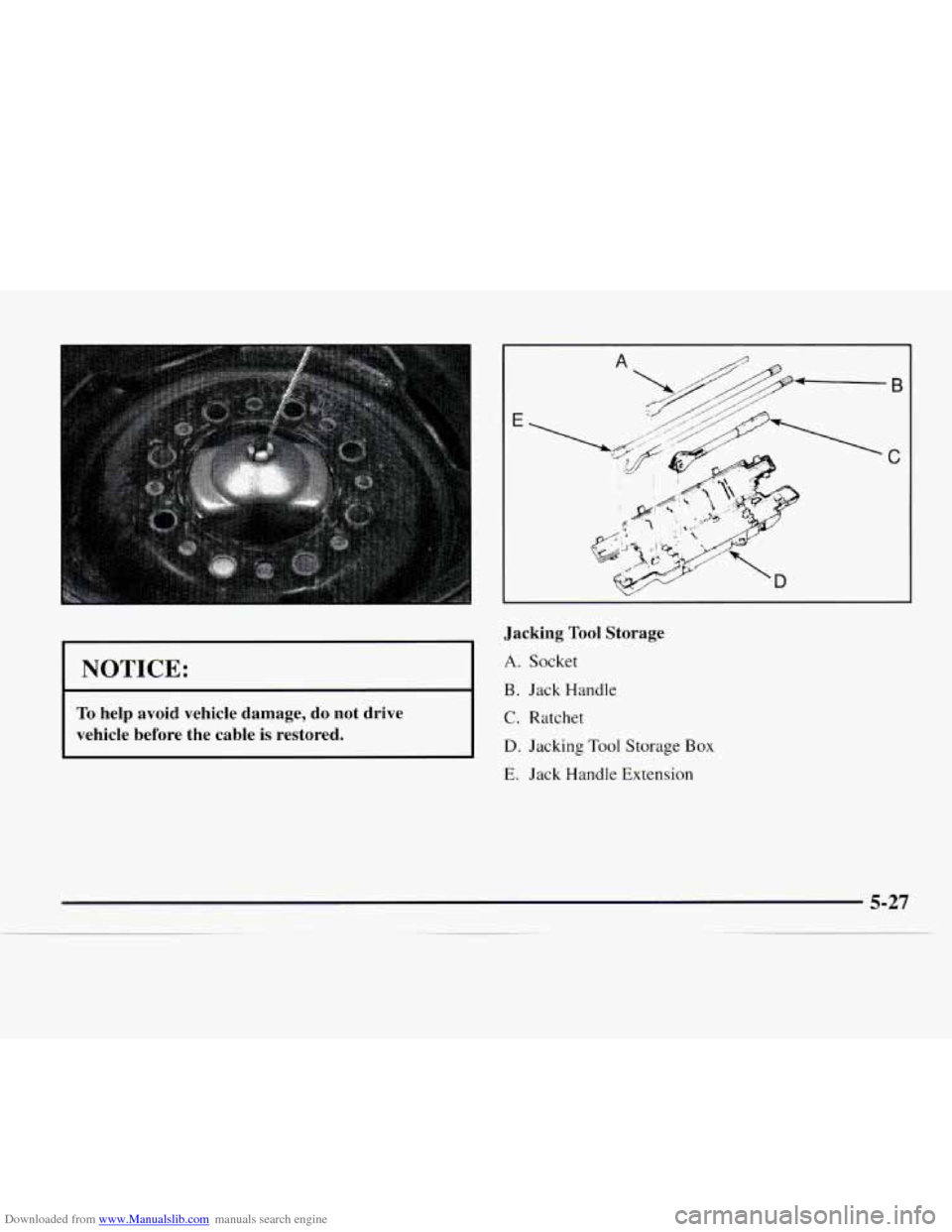
Downloaded from www.Manualslib.com manuals search engine I NOTICE:
To help avoid vehicle damage, do not drive
vehicle before the cable is restored.
A
E
Jacking Tool Storage
A. Socket
B. Jack Handle
C. Ratchet
D. Jacking Tool Storage Box
E. Jack Handle Extension